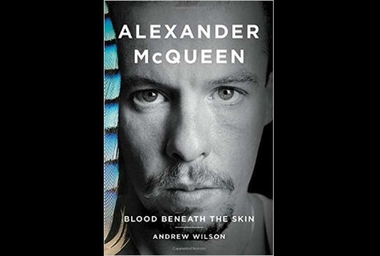Blood Beneath The Skin explores the life of famed fashion designer

By Bill O'Brien
The glamour, glitz and cutthroat competition found in the fashion industry were the subjects of the film The Devil Wears Prada, starring Meryl Streep. Those elements are also vividly portrayed by author Andrew Wilson in his biography of British fashion designer Alexander McQueen, titled Blood Beneath The Skin.
At the time of his suicide in 2010 at the age of forty, McQueen had climbed to the top of that industry and was designing clothes for a wide variety of celebrities. Attire for both men and women that bore his name was being sold at upscale stores such as Neiman Marcus. A similarly branded fragrance was available at cologne counters throughout the world.
Unlike many of his contemporaries in the fashion trade, McQueen was from a working class background. Wilson documents McQueen’s East London origins from a family of six headed by a taxi-driver father.
The future fashion designer realized at an early age that he was gay; he said that he “went from his mother’s womb to the Gay Parade.” His family was very supportive. He often spoke of how he was the “pink sheep of the McQueen family.”
At an early age, he was sexually abused by a man who was married to one of his sisters for a time, and the author concludes that that those serial assaults accounted in part for McQueen’s interest in violence and physical injury. The fashion shows that McQueen oversaw often featured women, and occasionally men, with what appeared to be blood smeared on them, and one of his early collections was titledMcQueen’s Theater of Cruelty.
He also designed the clothes that rock star David Bowie wore in several of his tours. American filmmaker Tim Burton, who has a vision that Wilson sees as being somewhat similar to McQueen’s, collaborated with him on several of his fashion shows.
The fashion designer shared his success with his family and purchased homes for his parents and several of his siblings. But happiness eluded McQueen despite his success, and in time, he became reliant on cocaine and other drugs. Like many chronic coke abusers, he became paranoid and suspicious of others. One of his associates is quoted as saying that while the fashion industry made McQueen very wealthy, the fashion designer himself made several drug dealers wealthy as well.
His romantic life was equally troubled, and he was unable to sustain any long-term relationships. While he did marry one of his boyfriends, the union lasted less than one year.
McQueen was very close to his mother, and he once said that his greatest fear was of out-living her. The fashion designer took his life nine days after her death on the day her funeral was scheduled. “Son, how could you do this to me,” his father wailed after hearing the news of his death as he was preparing for his wife’s funeral.
McQueen hung himself with a belt that he had designed and left a note apologizing for his suicide and asking that his two dogs be cared for. The resulting inquest noted that large quantities of cocaine and other drugs were found in his system. Alexander McQueen was interred on the Isle of Skye, which is off the Scottish coast. His tombstone describes him as “A beloved son-brother and uncle taken from our lives but never from our hearts.”
Bill O’Brien is an Oklahoma City attorney and writer.





